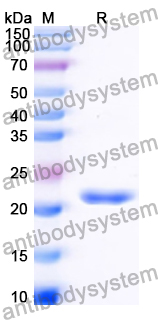Catalog No.
YHN49101
Expression system
E. coli
Species
Homo sapiens (Human)
Protein length
Pro263-Arg418
Predicted molecular weight
21.28 kDa
Nature
Recombinant
Endotoxin level
Please contact with the lab for this information.
Purity
>90% as determined by SDS-PAGE.
Accession
Q9H2G4
Applications
ELISA, Immunogen, SDS-PAGE, WB, Bioactivity testing in progress
Form
Lyophilized
Storage buffer
Lyophilized from a solution in PBS pH 7.4, 0.02% NLS, 1mM EDTA, 4% Trehalose, 1% Mannitol.
Reconstitution
Reconstitute in sterile water for a stock solution. A copy of datasheet will be provided with the products, please refer to it for details.
Shipping
In general, proteins are provided as lyophilized powder/frozen liquid. They are shipped out with dry ice/blue ice unless customers require otherwise.
Stability and Storage
Use a manual defrost freezer and avoid repeated freeze thaw cycles. Store at 2 to 8°C for frequent use. Store at -20 to -80°C for twelve months from the date of receipt.
Alternative Names
NP79, Nuclear protein of 79 kDa, CTCL-associated antigen se20-4, Cutaneous T-cell lymphoma-associated antigen se20-4, TSPY-like protein 2, DENTT, Differentially-expressed nucleolar TGF-beta1 target protein, Testis-specific Y-encoded-like protein 2, CDA1, Cell division autoantigen 1, TSPX, TSPYL2
SKIL Promotes Pancreatic Cancer Metastasis by Inhibiting TSPYL2 to Activate the TGF-β Pathway., PMID:40391200
Integrated bioinformatics and machine learning algorithms reveal the unfolded protein response pathways and immune infiltration in acute myocardial infarction., PMID:39552895
Biomarkers for Radiation Biodosimetry and Correlation with Hematopoietic Injury in a Humanized Mouse Model., PMID:39034036
Testis-Specific Protein, Y-Encoded-Like 2 Activates JAK2/STAT3 Pathway in Hypothalamic Paraventricular Nucleus to Sustain Hypertension., PMID:38782571
The role of Testis-Specific Protein Y-encoded-Like 2 in kidney injury., PMID:38665207
TSPYL1 as a Critical Regulator of TGFβ Signaling through Repression of TGFBR1 and TSPYL2., PMID:38588050
CRL2APPBP2-mediated TSPYL2 degradation counteracts human mesenchymal stem cell senescence., PMID:38170390
A tumor-suppressing role of TSPYL2 in thyroid cancer: Through interacting with SIRT1 and repressing SIRT1/AKT pathway., PMID:37696385
AAV9-Tspyl2 gene therapy retards bleomycin-induced pulmonary fibrosis by modulating downstream TGF-β signaling in mice., PMID:37391440
Single-cell protein activity analysis reveals a novel subpopulation of chondrocytes and the corresponding key master regulator proteins associated with anti-senescence and OA progression., PMID:37033917
Sex specific regulation of TSPY-Like 2 in the DNA damage response of cancer cells., PMID:36918555
Testis- specific Y-encoded- like protein 1 and cholesterol metabolism: Regulation of CYP1B1 expression through Wnt signaling., PMID:36518674
Ginsenoside Rg3 increases gemcitabine sensitivity of pancreatic adenocarcinoma via reducing ZFP91 mediated TSPYL2 destabilization., PMID:36090681
Unfolded Protein Response-Related Signature Associates With the Immune Microenvironment and Prognostic Prediction in Osteosarcoma., PMID:35754801
TSPYL2 reduced gefitinib resistance and DNA damage repair via suppressing SIRT1-mediated FOXO3 deacetylation., PMID:35192400
The Role of Cell Division Autoantigen 1 (CDA1) in Renal Fibrosis of Diabetic Nephropathy., PMID:33997036
hCINAP serves a critical role in hypoxia‑induced cardiomyocyte apoptosis via modulating lactate production and mitochondrial‑mediated apoptosis signaling., PMID:33300073
Role of Phagocytosis in the Pro-Inflammatory Response in LDL-Induced Foam Cell Formation; a Transcriptome Analysis., PMID:32012706
Targeted sequencing with a customized panel to assess histological typing in endometrial carcinoma., PMID:30710169
TSPYL2 Regulates the Expression of EZH2 Target Genes in Neurons., PMID:30051352
TSPYL2 is a novel regulator of SIRT1 and p300 activity in response to DNA damage., PMID:30050056
Battle of the sexes: contrasting roles of testis-specific protein Y-encoded (TSPY) and TSPX in human oncogenesis., PMID:29974883
TSPYL Family Regulates CYP17A1 and CYP3A4 Expression: Potential Mechanism Contributing to Abiraterone Response in Metastatic Castration-Resistant Prostate Cancer., PMID:29027195
Adenylate kinase hCINAP determines self-renewal of colorectal cancer stem cells by facilitating LDHA phosphorylation., PMID:28516914
The Y-located proto-oncogene TSPY exacerbates and its X-homologue TSPX inhibits transactivation functions of androgen receptor and its constitutively active variants., PMID:28169398
The ATPase hCINAP regulates 18S rRNA processing and is essential for embryogenesis and tumour growth., PMID:27477389
Tspyl2 Loss-of-Function Causes Neurodevelopmental Brain and Behavior Abnormalities in Mice., PMID:26826030
Identification of a homozygous missense mutation in LRP2 and a hemizygous missense mutation in TSPYL2 in a family with mild intellectual disability., PMID:26529358
hCINAP negatively regulates NF-κB signaling by recruiting the phosphatase PP1 to deactivate IKK complex., PMID:26089539
Xp11.2 microduplications including IQSEC2, TSPYL2 and KDM5C genes in patients with neurodevelopmental disorders., PMID:26059843
TSPYL2 is an essential component of the REST/NRSF transcriptional complex for TGFβ signaling activation., PMID:25613376
Androgen-regulation of the protein tyrosine phosphatase PTPRR activates ERK1/2 signalling in prostate cancer cells., PMID:25592066
Withdrawal of skeletal muscle cells from cell cycle progression triggers differentiation of Toxoplasma gondii towards the bradyzoite stage., PMID:25131712
Hsa-miR-195 targets PCMT1 in hepatocellular carcinoma that increases tumor life span., PMID:25119594
The potential contributions of a Y-located protooncogene and its X homologue in sexual dimorphisms in hepatocellular carcinoma., PMID:25017435
The nucleosome assembly protein TSPYL2 regulates the expression of NMDA receptor subunits GluN2A and GluN2B., PMID:24413569
Genetic deletion of cell division autoantigen 1 retards diabetes-associated renal injury., PMID:23929772
hCINAP is a novel regulator of ribosomal protein-HDM2-p53 pathway by controlling NEDDylation of ribosomal protein S14., PMID:23246961
Exome sequencing of serous endometrial tumors identifies recurrent somatic mutations in chromatin-remodeling and ubiquitin ligase complex genes., PMID:23104009
hCINAP is an atypical mammalian nuclear adenylate kinase with an ATPase motif: structural and functional studies., PMID:22038794
The X-linked tumor suppressor TSPX interacts and promotes degradation of the hepatitis B viral protein HBx via the proteasome pathway., PMID:21829568
TSPYL2 is important for G1 checkpoint maintenance upon DNA damage., PMID:21738728
[Methylation profiling of the cell cycle regulating genes in placenta of human embryos with chromosomal mosaicism]., PMID:21634119
Role of the Y-located putative gonadoblastoma gene in human spermatogenesis., PMID:21204751
Depletion of hCINAP by RNA interference causes defects in Cajal body formation, histone transcription, and cell viability., PMID:20186459
Expression of the NR2B-NMDA receptor subunit and its Tbr-1/CINAP regulatory proteins in postmortem brain suggest altered receptor processing in schizophrenia., PMID:20175224
Role of Cell Division Autoantigen 1 (CDA1) in Cell Proliferation and Fibrosis., PMID:24710090
Cell division autoantigen 1 plays a profibrotic role by modulating downstream signalling of TGF-beta in a murine diabetic model of atherosclerosis., PMID:19847393
Escape from X chromosome inactivation is an intrinsic property of the Jarid1c locus., PMID:18971342
Differentially expressed nucleolar transforming growth factor-beta1 target (DENTT) exhibits an inhibitory role on tumorigenesis., PMID:18381359

